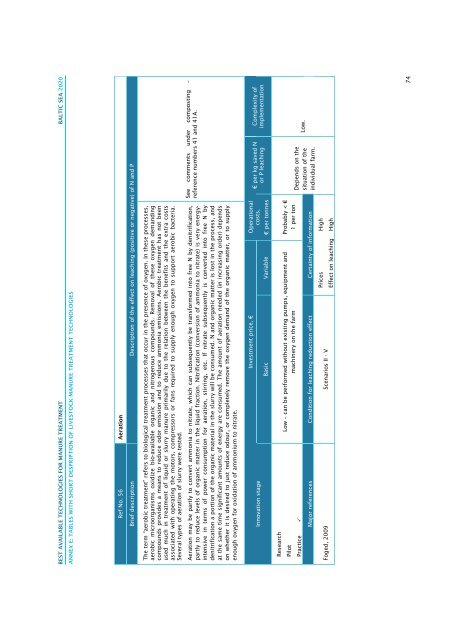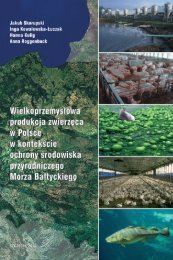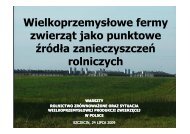best available technologies for manure treatment - Baltic Green Belt
best available technologies for manure treatment - Baltic Green Belt
best available technologies for manure treatment - Baltic Green Belt
You also want an ePaper? Increase the reach of your titles
YUMPU automatically turns print PDFs into web optimized ePapers that Google loves.
Best Available Technologies <strong>for</strong> <strong>manure</strong> <strong>treatment</strong> baltic sea 2020<br />
Best Available Technologies <strong>for</strong> <strong>manure</strong> <strong>treatment</strong> baltic sea 2020<br />
ANNEX E: TABLES WITH SHORT DESPRIPTION OF LIVESTOCK MANURE TREATMENT TECHNOLOGIES<br />
Ref No. 56 Aeration<br />
Brief description Description of the effect on leaching (positive or negative) of N and P<br />
The term “aerobic <strong>treatment</strong>” refers to biological <strong>treatment</strong> processes that occur in the presence of oxygen. In these processes,<br />
aerobic microorganisms oxidize bio-<strong>available</strong> organic and nitrogenous compounds. Removal of these oxygen demanding<br />
compounds provides a means to reduce odor emission and to reduce ammonia emissions. Aerobic <strong>treatment</strong> has not been<br />
used much in <strong>treatment</strong> of liquid or slurry <strong>manure</strong> primarily due to the relation between the benefits and the extra costs<br />
associated with operating the motors, compressors or fans required to supply enough oxygen to support aerobic bacteria.<br />
Several types of aeration of slurry were tested.<br />
Aeration may be partly to convert ammonia to nitrate, which can subsequently be trans<strong>for</strong>med into free N by denitrification,<br />
partly to reduce levels of organic matter in the liquid fraction. Nitrification (conversion of ammonia to nitrate) is very energyintensive<br />
in terms of power consumption <strong>for</strong> aeration, stirring, etc. If nitrate subsequently is converted into free N by<br />
denitrification a portion of the organic material in the slurry will be consumed. N and organic matter is lost in the process, and<br />
at the same time significant amounts of energy are consumed. The amount of aeration needed (in increasing order) depends<br />
on whether it is desired to just reduce odour, or completely remove the oxygen demand of the organic matter, or to supply<br />
enough oxygen <strong>for</strong> oxidation of ammonium to nitrate.<br />
See comments under composting –<br />
reference numbers 41 and 41A.<br />
Innovation stage<br />
Investment price, <br />
Basic Variable<br />
Operational<br />
costs,<br />
per tonnes<br />
per kg saved N<br />
or P leaching<br />
Complexity of<br />
implementation<br />
Research<br />
Pilot<br />
Practice <br />
Low – can be per<strong>for</strong>med without existing pumps, equipment and<br />
machinery on the farm<br />
Probably < <br />
1 per ton<br />
Major references Condition <strong>for</strong> leaching reduction effect Certainty of in<strong>for</strong>mation<br />
Foged, 2009 Scenarios II - V<br />
Prices High<br />
Effect on leaching High<br />
Depends on the<br />
situation of the<br />
individual farm.<br />
Low.<br />
74<br />
74








